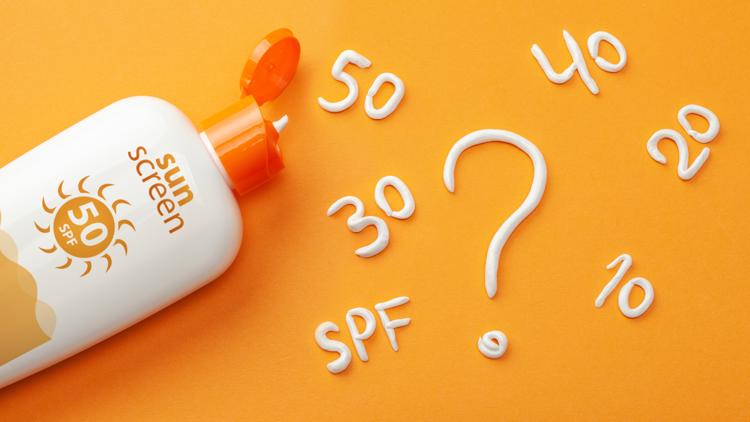The weather is getting warmer and many Americans are spending a lot of time outdoors soaking up the sun and, hopefully, putting on sunscreen to protect their skin.
Applying sunscreen regularly and correctly is a vital tool in the fight against skin cancer, including melanoma, the most serious form, according to the American Academy of Dermatology Association.
We’re VERIFYING four facts about how to protect your skin from the sun’s rays this summer.
THE SOURCES
- U.S. Centers for Disease Control and Prevention
- U.S. Food and Drug Administration
- American Academy of Dermatology Association
- American Cancer Society
- Mayo Clinic
- Melanoma Research Alliance
- Skin Cancer Foundation
- Danilo Del Campo, M.D., board-certified dermatologist at the Chicago Skin Clinic
- Rutledge Forney, M.D., board-certified dermatologist and founder of Dermatology Affiliates in Atlanta, Georgia
- Adam Friedman, M.D., professor and chair of dermatology at the George Washington University Medical Faculty Associates
- Corey Hartman, M.D., board-certified dermatologist, and the founder and medical director at Skin Wellness Dermatology in Birmingham, Alabama
- Rajani Katta, M.D., board-certified dermatologist and founder of Katta Dermatology in Bellaire, Texas
WHAT WE FOUND
1. Spray sunscreen is as effective as lotion sunscreen
Spray sunscreen can be more convenient than lotion sunscreen, but many people wonder whether it’s as effective. We can VERIFY that spray sunscreen is just as effective as lotion sunscreen, but both must be applied correctly to work best, according to our sources.
“Anything that has the word sunscreen or sunblock is highly regulated by the FDA, so on a molecular and scientific level, yes — between a lotion that has SPF 30 and a spray that’s SPF 30, they are equivalent,” said Danilo Del Campo, M.D., a board-certified dermatologist at the Chicago Skin Clinic.
“However, the difference is how we apply it and the method that we apply it,” Del Campo noted.
After applying a spray sunscreen, it is important to make sure it is glistening on the skin before rubbing it in to get an even layer of coverage, Del Campo and board-certified dermatologist Rajani Katta, M.D., both say.
“I know some of the products say that they’re just ‘spray-and-go,’ but that’s not what I recommend,” said Katta. “I recommend that you spray and then you make sure that you rub it in so that you’re not missing any spots.”
Del Campo also recommends applying spray sunscreen about 15 to 20 minutes prior to being exposed to the sun and before participating in any water activities.
“All of those sprays have a certain alcohol content on it, so it takes a little while for the alcohol to evaporate and for the actual chemical ingredient to bind,” said Del Campo.
Katta does not recommend spraying sunscreen directly on the face, especially children’s faces. Instead, she says people should first spray the sunscreen on their hand and then rub it in before applying it or use a separate sunscreen lotion for the face in order to avoid inhaling the spray-on kind.
“You have to be extra careful with your face in terms of getting adequate coverage,” said Katta.
To safely and adequately use spray sunscreen, the American Academy of Dermatology Association recommends following these tips:
- Hold the nozzle close to your skin and spray generously until your skin glistens.
- Rub it in thoroughly after spraying to ensure that you didn’t miss any spots and that you have an even layer of coverage.
- Avoid inhaling spray sunscreen and never spray sunscreen around or near your face or mouth.
- Avoid using spray sunscreen on windy days because these conditions make it more difficult to apply sunscreen and easier to accidentally inhale it.
- Never apply a spray sunscreen near heat or open flame, or while smoking, and make sure it is thoroughly rubbed in and dry before approaching any open flames.
2. There is a difference between SPF and UPF
The labels on sunscreens or sunblocking clothing can be confusing, including the labels that say either “SPF” or “UPF.” We can VERIFY there is a difference between Sun Protection Factor (SPF) and Ultraviolet Protection Factor (UPF).
SPF is a rating for sunscreens that measures how long the product offers protection, while UPF is a rating for clothing that measures how much of the sun’s rays the product blocks.
SPF is based on how much solar energy — or UV radiation — your skin absorbs, according to the U.S. Food and Drug Administration (FDA). That means how long you’re protected also depends on factors like the intensity of the sun’s rays and where you are relative to the Earth’s equator.
The sun produces two kinds of UV rays: UVA and UVB. UVA causes your skin to age and UVB causes your skin to burn, but both increase your risk of skin cancer.
It’s important to keep in mind that SPF only measures protection against UVB rays. That’s why the Skin Cancer Foundation says it’s important to use “broad spectrum” sunscreen, which can effectively protect against both UVA and UVB rays.
UPF protection, on the other hand, is a measurement that indicates what percentage of the sun’s rays penetrate your clothing, according to the Melanoma Research Alliance.
A UPF 30 shirt, for example, blocks about 97% of the sun’s rays, only allowing 1/30th of them through. Meanwhile, a UPF 50 shirt blocks 98% of the sun’s rays, only allowing 1/50th of them through and a UPF 100 blocks 99% of the sun’s rays, only allowing 1/100th of them through.
All clothing has some level of UPF protection, but not all clothing comes with a UPF label. The Skin Cancer Foundation recommends clothing of at least 30 UPF for adequate sun protection.
“The difference between clothing that has a designated UPF versus that which does not is that it has been tested and evaluated,” said Adam Friedman, M.D., professor and chair of dermatology at the George Washington University Medical Faculty Associates.
“That doesn’t mean that your clothing can’t confer some protection, but there are certain things to look for if you’re not going to utilize UPF-labeled clothing,” Friedman added.
The Melanoma Research Alliance says that UPF-labeled clothing is specifically designed to shield you from UV rays, which means that it can remain protective even if made from thinner fabrics or lighter colors.
SPF doesn’t quite work the same way, the FDA warns. Sunscreens wear off and become less effective with time, so your skin will absorb more of the sun’s rays if you apply a thinner layer of sunscreen or if you don’t reapply it regularly enough, regardless of the SPF.
There is no perfect way to fully protect yourself from the sun. If you’re going to be outside in the sun for an extended period of time, the best thing you can do is give yourself as much protection as possible, Friedman says.
“I think you want to take a combination approach,” Friedman said. “That includes using sunscreen SPF 30 or higher and clothing to protect the exposed areas.”
3. Reapply sunscreen at least every two hours while outside
You’ll find lots of people sharing tips online with claims about just how often you should reapply sunscreen.
All of our sources recommend reapplying sunscreen at least every two hours, especially after swimming, sweating or toweling off.
“We know that after about two hours, the sunscreen ingredients don’t work as well to protect you …. so that reapplication is just to make sure you’re being protected from the harmful and carcinogenic effects of the sun,” said Friedman.
The U.S. Centers for Disease Control and Protection (CDC) agrees.
“Sunscreen wears off. Put it on again if you stay out in the sun for more than two hours and after swimming, sweating, or toweling off,” the CDC says.
So just how much sunscreen should you be using? Friedman says you’ll want to slather on a shot-glass full, which is about 1.5 ounces, for your body.
“This is roughly the amount of sunscreen you would need to cover the areas that will be exposed when outdoors,” Friedman said.
4. Sunscreen does expire, but not every bottle will have an expiration date
We all know the importance of wearing sunscreen to protect yourself when you’re out and enjoying summer fun, but how long can you use that bottle of sunscreen at the bottom of your beach bag?
The FDA requires all nonprescription drugs, including sunscreen, to have an expiration date unless the manufacturer’s stability testing has shown that the product will remain stable for at least three years.
This means a sunscreen product that doesn’t have an expiration date should be considered expired three years after purchase, the FDA says on its website.
“Once expired, you have no idea how much protection you’re getting, and the whole point is to protect yourself from aging and skin cancer,” dermatologist Rutledge Forney, M.D. told VERIFY.
In addition to monitoring expiration dates, the American Academy of Dermatology recommends looking for “visible signs that the sunscreen may no longer be good,” including changes in color or consistency.
The shelf life of sunscreen can also decrease when exposed to high temperatures, according to Forney and the Mayo Clinic.
“Most people have left their sunscreen someplace, and they pull it out and shake it up and it’s separated and yucky,” Forney said. “Even if it’s not expired, if it gets too hot, you can definitely have the ingredients breakdown.”
To make sure that your sunscreen is providing the sun protection promised on its label, the FDA recommends that you:
- Do not use sunscreen products that have passed their expiration date (if there is one).
- Do not use sunscreen products that have no expiration date and were not purchased within the last three years.
- Discard expired sunscreens because they may not be safe and effective anymore. If you do not know how old your sunscreen is, discard it.
This story is also available in Spanish / Lee este artículo también en español: Los cuidados en el sol: 4 datos verificados



